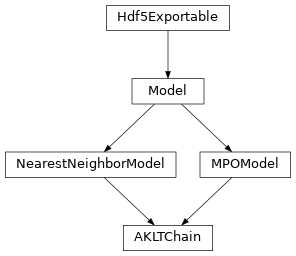AKLTChain¶
full name: tenpy.models.aklt.AKLTChain
parent module:
tenpy.models.aklttype: class
Inheritance Diagram

Methods
|
|
Calculate bond energies <psi|H_bond|psi>. |
|
|
Calculate the MPO Hamiltonian from the bond Hamiltonian. |
|
Calculate the bond Hamiltonian from the MPO Hamiltonian. |
Shallow copy of self. |
|
|
Repeat the unit cell for infinite MPS boundary conditions; in place. |
|
Return a (shallow) copy with extracted segment of MPS. |
|
Initialize a NearestNeighborModel from a model class defining an MPO. |
|
Load instance from a HDF5 file. |
|
Modify self in place to group sites. |
|
Export self into a HDF5 file. |
|
|
Return a NearestNeighborModel with same lattice, but trivial (H=0) bonds. |
Class Attributes and Properties
|
class attribute. |
- class tenpy.models.aklt.AKLTChain(model_params)[source]¶
Bases:
tenpy.models.model.NearestNeighborModel,tenpy.models.model.MPOModelA simple implementation of the AKLT model.
Here we define the Hamiltonian on a chain of S=1 spins as originally defined by Affleck, Kennedy, Lieb, Tasaki in [affleck1987], but dropping the constant parts of 1/3 per bond and rescaling with a factor of 2, such that we expect a ground state energy of
E_0 = - (L-1) 2/3 * J.\[H = J \sum_i 2* P^{S=2}_{i,i+1} + const = J \sum_i (\vec{S}_i \cdot \vec{S}_{i+1} +\frac{1}{3} (\vec{S}_i \cdot \vec{S}_{i+1})^2)\]- bond_energies(psi)[source]¶
Calculate bond energies <psi|H_bond|psi>.
- Parameters
psi (
MPS) – The MPS for which the bond energies should be calculated.- Returns
E_bond – List of bond energies: for finite bc,
E_Bond[i]is the energy of bondi, i+1. (i.e. we omit bond 0 between sites L-1 and 0); for infinite bcE_bond[i]is the energy of bondi-1, i.- Return type
1D ndarray
- calc_H_MPO_from_bond(tol_zero=1e-15)[source]¶
Calculate the MPO Hamiltonian from the bond Hamiltonian.
- calc_H_bond_from_MPO(tol_zero=1e-15)[source]¶
Calculate the bond Hamiltonian from the MPO Hamiltonian.
- Parameters
tol_zero (float) – Arrays with norm < tol_zero are considered to be zero.
- Returns
H_bond – Bond terms as required by the constructor of
NearestNeighborModel. Legs are['p0', 'p0*', 'p1', 'p1*']- Return type
list of
Array
:raises ValueError : if the Hamiltonian contains longer-range terms.:
- enlarge_mps_unit_cell(factor=2)[source]¶
Repeat the unit cell for infinite MPS boundary conditions; in place.
This has to be done after finishing initialization and can not be reverted.
- Parameters
factor (int) – The new number of sites in the MPS unit cell will be increased from N_sites to
factor*N_sites_per_ring. Since MPS unit cells are repeated in the x-direction in our convetion, the lattice shape goes from(Lx, Ly, ..., Lu)to(Lx*factor, Ly, ..., Lu).
- extract_segment(*args, **kwargs)[source]¶
Return a (shallow) copy with extracted segment of MPS.
- Parameters
first (int) – See
extract_segment().last (int) – See
extract_segment().enlarge (int) – See
extract_segment().
- Returns
cp – A shallow copy of self with MPO and lattice extracted for the segment.
- Return type
Model
- classmethod from_MPOModel(mpo_model)[source]¶
Initialize a NearestNeighborModel from a model class defining an MPO.
This is especially usefull in combination with
MPOModel.group_sites().- Parameters
mpo_model (
MPOModel) – A model instance implementing the MPO. Does not need to be aNearestNeighborModel, but should only have nearest-neighbor couplings.
Examples
The SpinChainNNN2 has next-nearest-neighbor couplings and thus only implements an MPO:
>>> from tenpy.models.spins_nnn import SpinChainNNN2 >>> nnn_chain = SpinChainNNN2({'L': 20}) >>> print(isinstance(nnn_chain, NearestNeighborModel)) False >>> print("range before grouping:", nnn_chain.H_MPO.max_range) range before grouping: 2
By grouping each two neighboring sites, we can bring it down to nearest neighbors.
>>> grouped_sites = nnn_chain.group_sites(2) >>> print("range after grouping:", nnn_chain.H_MPO.max_range) range after grouping: 1
Yet, TEBD will not yet work, as the model doesn’t define H_bond. However, we can initialize a NearestNeighborModel from the MPO:
>>> nnn_chain_for_tebd = NearestNeighborModel.from_MPOModel(nnn_chain) >>> isinstance(nnn_chain_for_tebd, NearestNeighborModel) True
- classmethod from_hdf5(hdf5_loader, h5gr, subpath)[source]¶
Load instance from a HDF5 file.
This method reconstructs a class instance from the data saved with
save_hdf5().- Parameters
hdf5_loader (
Hdf5Loader) – Instance of the loading engine.h5gr (
Group) – HDF5 group which is represent the object to be constructed.subpath (str) – The name of h5gr with a
'/'in the end.
- Returns
obj – Newly generated class instance containing the required data.
- Return type
cls
- group_sites(n=2, grouped_sites=None)[source]¶
Modify self in place to group sites.
Group each n sites together using the
GroupedSite. This might allow to do TEBD with a Trotter decomposition, or help the convergence of DMRG (in case of too long range interactions).This has to be done after finishing initialization and can not be reverted.
- Parameters
n (int) – Number of sites to be grouped together.
grouped_sites (None | list of
GroupedSite) – The sites grouped together.
- Returns
grouped_sites – The sites grouped together.
- Return type
list of
GroupedSite
- save_hdf5(hdf5_saver, h5gr, subpath)[source]¶
Export self into a HDF5 file.
This method saves all the data it needs to reconstruct self with
from_hdf5().This implementation saves the content of
__dict__withsave_dict_content(), storing the format under the attribute'format'.